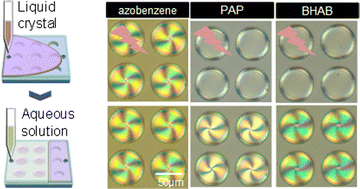Formation of topological defects at liquid/liquid crystal interfaces in micro-wells controlled by surfactants and light†
Abstract
Topological defects, the fundamental entities arising from symmetry-breaking, have captivated the attention of physicists, mathematicians, and materials scientists for decades. Here we propose and demonstrate a novel method for robust control of topological defects in a liquid crystal (LC), an ideal testbed for the investigation of topological defects. A liquid layer is introduced on the LC in microwells in a microfluidic device. The liquid/LC interface facilitates the control of the LC alignment thereby introducing different molecules in the liquid/LC phase. A topological defect is robustly formed in a microwell when the liquid/LC interface and the microwell surface impose planar and homeotropic alignment, respectively. We also demonstrate the formation/disappearance of topological defects by light illumination, realized by dissolving photo-responsive molecules in the LC. Our platform that facilitates the control of LC topological defects by the introduction of different molecules and external stimuli could have potential for sensor applications.



 Please wait while we load your content...
Please wait while we load your content...